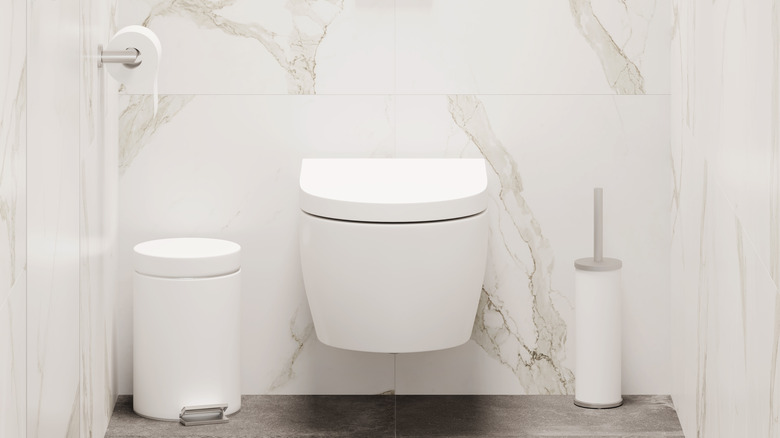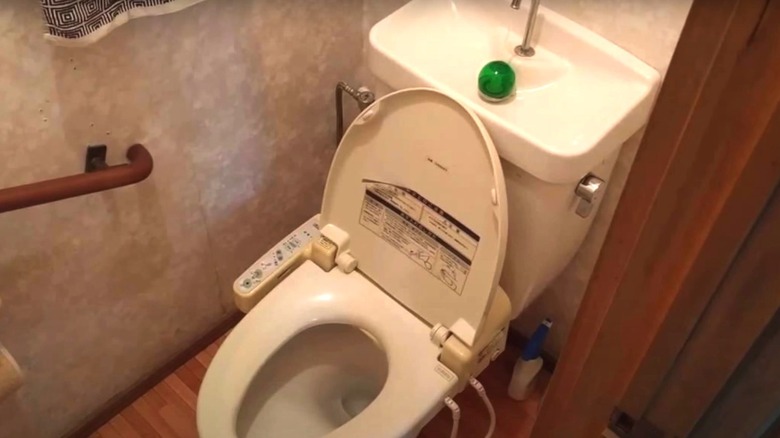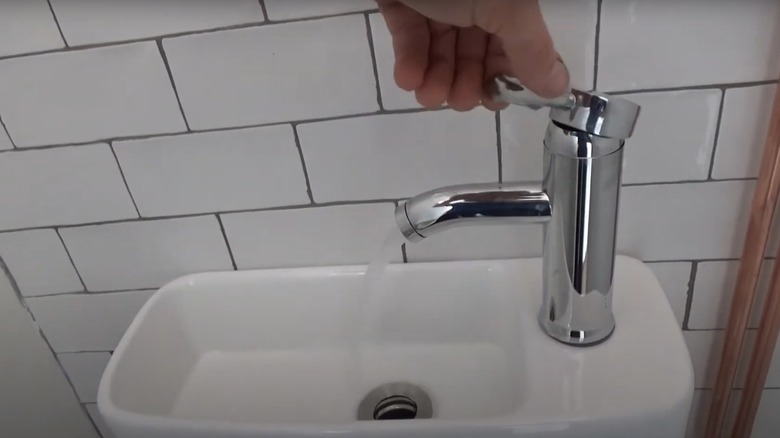This Type Of Toilet May Be A The Solution To Your Small Bathroom Woes
We may receive a commission on purchases made from links.
When you need to make the most of a small bathroom, you have quite a few ideas and options. One you may want to consider is an integrated sink on a toilet. By eliminating the need for a separate sink, you can make the most of the space in a tiny bathroom. If you and your spouse are using a roomy single or double vanity in your master bathroom, switching to an integrated sink on a toilet may feel like a shocking difference. However, when space is at a premium, the creativity of an integrated sink and toilet could be the perfect idea.
A toilet tank sink sits atop the toilet where the cover to the tank would be. Any water you use for washing your hands or other grooming tasks would run into the tank of the toilet where it's stored until you need to flush. If you're worried about sanitation, don't be — the water supply for the sink comes from your main home's water supply. The connected sink grabs the water meant to refill the toilet tank, so it never touches the interior of the toilet tank until it drains through the sink.
These combination bathroom appliances started appearing in Japanese bathrooms a few decades ago, but you may not be as familiar with them in North America. We'll break down how you can find and install one as well as the pros and cons of this design.
How to install a toilet tank sink
If you want to purchase a toilet tank sink, Home Depot offers the Sinkpostive model that costs $107. Because it's all white, it should match a typical toilet. With dimensions of 17 by 9 inches, it's made to fit over the top of a standard toilet in place of the cover, so almost anyone should be able to take advantage of it. If you've worked on repairing or installing toilets previously, you should be able to do it as a DIY job. The manufacturers of these tank sinks try to make the job as easy as possible for DIY-ers. However, you can also choose to call a licensed plumber, who should be able to do the job quickly.
To install a basic model, turn off the water supply to the toilet and remove the cover from the tank. Attach the water supply line for the sink to the supply line for the tank. The drain line from the sink should go through the overflow pipe inside the tank. Make sure the lines have no kinks in them and don't get pinched underneath the sink when you place it over the top of the tank. Turn the water supply back on and watch for leaks. If everything is tight, some manufacturers still recommend placing small amounts of putty on all four corners of the tank to help hold the sink in place in case of an inadvertent bump.
Pros and cons of using integrated sinks with toilets
Beyond being a solution to take advantage of a really small bathroom, one of the biggest benefits of this integrated sink and toilet design is its ability to save water in your bathroom. Because the water that you drain through the sink becomes reusable in the toilet tank when it's time to flush, you're saving a bit of water. A single flush can require 3 gallons of water, so every little bit you can reuse is helpful for the environment. Even if you conserve only a tenth of the water from each normal flush (or 0.3 gallons) and if you flush five times a day like an average household, you'd save 1.5 gallons of each day, about 45 gallons a month, and almost 550 gallons per year.
Perhaps the biggest disadvantage of this type of design is that you typically don't have a hot water source for the sink. Because it connects directly to the tank fill pipe, it only has cold water available. Another issue is the awkward location of the sink. It's difficult to stand comfortably and use the sink because the toilet bowl is in the way. Because you're standing awkwardly, you might end up with water running down your arms and onto the floor until you get the hang of using it.


